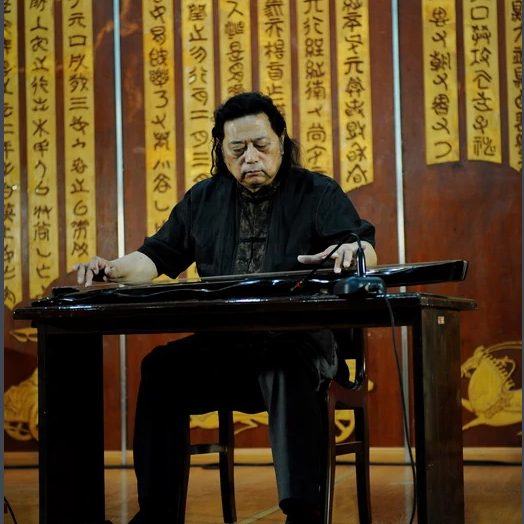Ding chengyun
Organized by 愛 on 2022-02-24

Ding Chengyun, No. Yimen Lay, was originally from Dengzhou, Henan, and was born in Kaifeng, Henan in March 1944. Guqin master. He learned qin and zheng from his sister Ding Boqin since childhood, and later studied with Gu Meigeng and Zhang Ziqian, masters of guqin, and traveled with Zhongzhou qin masters Chen Zhongsi, Chen Shusan and Huang Songtao, and Zhongzhou zheng master Wang Shengwu.
For more than 40 years, he has devoted himself to the excavation and research of Chinese music rhythm and Zhongzhou Zheng School, the development of qin, ser and zheng instruments, and the discovery and restoration of the ancient serge strings and playing methods that have been lost for more than a thousand years. Promote the dying Zhongzhou ancient tune, advocate the promotion of traditional Chinese music traditions, etc.
Played and discovered more than ten qin songs such as "Shen Ren Chang", "Bai Xue", "Liu He You", "Flowing Springs on the Stone", "Qing Yun Song", "Xu Si Yin", "Flowing Spots" and so on. He is the representative of the contemporary Zhongzhou Qin School and Zhongzhou Zheng School. He has loved Chinese culture and art since childhood. Since he was 13 years old, he has successively studied poetry, calligraphy and painting from Mr. Jin Zhi, Wu Muyao and Cai Dequan. He also learned Shaolin and Tai Chi Kungfu from seniors such as Lu Wenqu and Fan Jingyi. As the saying goes, the skill of playing the qin is outside the qin and benefits a lot.
The cultural foundation laid in Kaifeng had a significant impact on his aesthetic orientation and artistic development in the future, and the Chinese Kung Fu he learned had a great relationship with the unique cotton-wrapped iron pronunciation he later played on the piano.
Similar artist
Yang Qing, a famous guqin master and music educator, was born in August 1951.
read >>
Ni Shiyun, a native of Haimen District, Nantong City, Jiangsu Province, China's famous contemporary qin mojo, the fourth generation inheritor of the Mei 'an Qin School, the representative inheritor of the intangible cultural heritage of Jiangsu Province "Guqin art" (Mei 'an Qin school), serves as the director of the Chinese Kunqu Opera Guqin Research Institute and the executive director of the Chinese Qin Association.
read >>
Yang Qiong, the word Yu Rong, Yushan Qin school successor, South Yuqin Club president, operation aman for more than ten years, good at qin songs. He is currently the vice president of Shenzhen Guqin Association, member of Shenzhen Ethnic Orchestral Association, lecturer of Shenzhen University School of Continuing Education and so on.
read >>
Yang Zhijian, Guqin maker and performer. Born in Shanghai in July 1974. National first-class performer; representative inheritor of Shanghai intangible cultural heritage "Guqin-making skills"; vice-chairman of Shanghai Intangible Cultural Heritage Protection Association. Winner of "Shanghai Craftsman" and "May 1st Labor Medal" in 2017.
read >>
Huang Deyuan, inheritor of the intangible cultural heritage "Zhejiang style guqin" and "Wenzhou dialect recitation".
read >>
Involving musical instruments
Guqin (pinyin: Gǔ Qín) is a traditional Chinese musical instrument with a history of at least 3,500 years. Guqin is also known as Yaoqin, Yuqin and Seven-stringed Qin. The guqin has 13 emblems that mark the rhythm, and is also a ritual and musical instrument. It belongs to the silk in the octave. Guqin has a wide range, deep timbre and long aftertone.
Guzheng (pinyin: Gǔ Zhēng), also known as Hanzheng and Qinzheng, is an ancient national musical instrument of the Han nationality and is popular all over China. It is often used for solo, duet, instrumental ensemble and accompaniment of song and dance, opera and folk art. Because of its wide range, beautiful timbre, rich playing skills and strong expressiveness, it is known as the "King of Music", also known as "Oriental Piano", and is one of the unique and important national musical instruments in China.
Involved portfolio
Involved news
Organized by 陆晨 on 2025-04-17
The guqin, as a treasure of traditional Chinese culture, with its unique timbre and profound cultural background, has become a choice for many people to pursue inner peace. However, for many enthusiasts, how to squeeze out time from a busy schedule to self-study the guqin is no small challenge.
read >>
Organized by 苏肆 on 2025-04-03
In the long river of ancient Chinese music, Guqin occupies an irreplaceable position with its profound cultural connotation and unique timbre. Among the many famous Guqin songs, "Snow White" is like a bright pearl, with its quiet and elegant style, it has become a classic beloved by scholars of all ages.
read >>
Organized by 没头脑 on 2025-03-31
"Autumn Wild Geese" is a brilliant gem in the treasure house of ancient Chinese guqin music. It is not only renowned worldwide for its profound and distant artistic conception, but also has become a classic work passed down by later generations due to its unique artistic charm and profound ideological connotation.
read >>
Organized by 天井 on 2025-03-07
The guqin, as a treasure among traditional Chinese musical instruments, with its profound timbre and rich cultural connotations, has become an important medium for scholars and refined people to cultivate their character and express their sentiments. Among the numerous guqin pieces, "Pu'an Zuo" stands out as a highly representative work with its unique Buddhist background and the distant and meditative musical style.
read >>
Organized by 肖毅 on 2025-02-26
In the vast starry sky of Chinese classical music, guqin pieces occupy an important place with their profound cultural background and unique artistic charm. Among them, "The Four Scenic Views" is a highly representative work that not only showcases the exquisite and far-reaching artistic conception of guqin music but also leads the listener into a world brimming with vitality and vigor.
read >>

 渝公网安备 50010702504639号
渝公网安备 50010702504639号